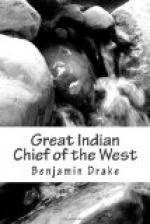Stillman’s defeat spread consternation throughout the state of Illinois. The Indian forces were greatly magnified in number, and Black Hawk’s name carried with it associations of uncommon military talent, and of savage cunning and cruelty. General Atkinson proceeded to fortify his camp, at Dixon’s ferry, and the Executive of the state made a call for more mounted volunteers. The Secretary at War sent about 1000 United States’ troops from the sea-board to the scene of action; and General Winfield Scott was ordered to proceed to the north west, and direct the future operations of the campaign. A bloody border contest ensued. Many frontier families were massacred with savage ferocity, and some were carried into captivity. A party of Pottowattomies, thirty in number, fell upon a little settlement on Indian creek, one of the tributaries of Fox river, and murdered fifteen men, women and children, taking two prisoners, the Misses Hall; who were subsequently placed in charge of some Winnebagoes, and by them returned in safety, a few weeks afterwards, to their friends. At Kellog’s grove, not far from Galena, in the early part of June, a party of Indians stole some horses. Captain J. W. Stephenson pursued them with twelve men. A skirmish ensued, which resulted in the death of three of our troops and five or six of the enemy. On the evening of the 14th of June, a party of eleven Sacs, killed five white men at Spafford’s farm. General Dodge with twenty-nine men, followed and overtook them in a swamp, where the whole were shot down and scalped, they having first killed three of Dodge’s men. The barbarous practice of scalping the dead, was in this case adopted by our troops and sanctioned by their officers.[9]




